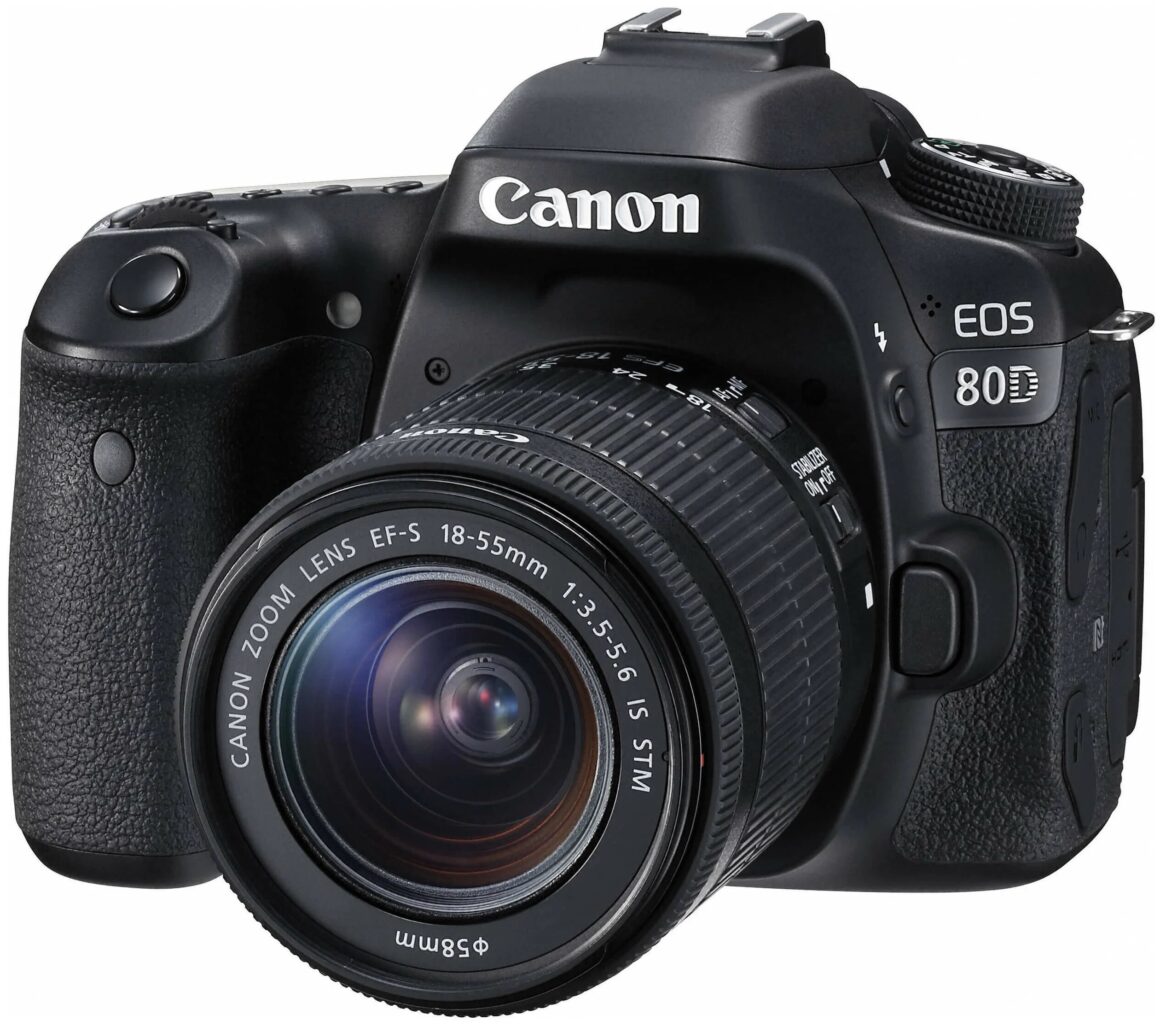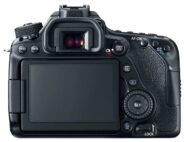Canon EOS 80D
APS-C AF digital SLR camera
Specification
| Production details: | |
| Announced: | February 2016 |
| System: | ● Canon EOS APS-C (2003) |
| Format: | |
| Maximum format: | APS-C |
| Imaging sensor: | 22.3 × 14.9mm CMOS sensor |
| Resolution: | 6000 × 4000 - 24 MP |
| Crop factor: | 1.61x |
| Sensor-shift image stabilization: | - |
| Mount and Flange focal distance: | Canon EF-S [44mm] |
| Shutter: | |
| Type: | Focal-plane |
| Model: | Electronically controlled |
| Speeds: | 30 - 1/8000 + B |
| Exposure: | |
| Exposure metering: | Through-the-lens (TTL), open-aperture |
| Exposure modes: | Programmed Auto |
| Aperture-priority Auto | |
| Shutter-priority Auto | |
| Manual | |
| Physical characteristics: | |
| Weight: | 730g |
| Dimensions: | 139x105.2x78.5mm |
Manufacturer description
MELVILLE, N.Y., February 17, 2015 – Artists looking to turn their passion into popular online videos or to show the world their unique perspective through social networks now have a new tool available to them that helps them tear down creative barriers and produce dynamic visual content for both still and video. Canon U.S.A., Inc., a leader in digital imaging solutions, is proud to introduce the new Canon EOS 80D Digital SLR camera, featuring an new 45-point AF system1, 24.2 megapixel CMOS sensor for crisp images with fine detail. For the budding videographer or online video star, the camera features Dual Pixel CMOS Autofocus (DAF) technology coupled with an intuitive touchscreen capability for easy focusing when shooting video.
Canon is also introducing a new EF-S 18-135mm f/3.5-5.6 IS USM lens optimized for high-speed autofocusing when shooting stills and quiet and smooth zoom when shooting video. The lens is also compatible with Canon’s new Power Zoom Adapter for smooth cinematic ‘pulls’ when changing focal length on a subject, and responsive adjustments at the push of a button for stills or video.
Updated features in Canon EOS 80D DSLR Camera include:
- New 45-point all cross-type AF system
- Intelligent Viewfinder with approximately 100% viewfinder coverage
- Newly Developed 24.2 Megapixel (APS-C) CMOS sensor
- DIGIC 6 image processor for enhanced image quality
- Improved Dual Pixel CMOS AF for smooth, fast and accurate autofocus with video and stills
- Built-in Wi-Fi 2 and NFC2 capability for easy transfer of images and movies to compatible mobile devices
- 1080/60p Full HD video to capture brilliant results in MP4 format for easy movie sharing on select social networking sites
- Vari-angle Touch Screen 3.0-inch Clear View LCD II monitor enables flexible positioning and clear viewing even outdoors
“In today’s world, where everyone is a photographer or videographer, we at Canon are looking to provide the tools and features that help creative-minded people stand out from the pack and get noticed. The right technology cannot make someone creative, but it will help bring a creative vision to life,” said Yuichi Ishizuka, president and COO, Canon U.S.A., Inc. “The right combination of camera and lens helps those with a vision stand out and be recognized. We look forward to seeing what this new generation of passionate artists will create with these new tools.”
New AF System and Dual Pixel CMOS AF
The 45-point all cross-type viewfinder AF system in the new Canon EOS 80D DSLR camera, compared to 19-points in the Canon EOS 70D DSLR camera, is now wider both horizontally and vertically for easier compositions with off-center subjects. Low light AF performance has been improved all the way down to EV-3 at the center point to achieve sharp results even in extreme low-light situations. The camera’s AI (Artificial Intelligence) Servo AF II autofocusing system utilizes color tracking with a 7,560-pixel RGB+IR metering sensor that automatically detects skin tone and colors to enhance tracking sensitivity, even with moving subjects that are rapidly changing pace or direction. Enhancing the ease-of-use of the new AF system is the Canon EOS 80D’s new Intelligent Viewfinder which features approximately 100% viewfinder coverage. The full coverage helps prevent photographers from missing objects that are in the corners of the scene, which can reduce the need to crop images later on.
Dual Pixel CMOS AF employs a new Canon CMOS sensor with which all of the effective pixels are able to perform both still imaging and phase-detection AF simultaneously to achieve dramatically improved AF performance during Live View and video shooting. The Dual Pixel CMOS AF technology in the Canon EOS 80D camera features enhanced tracking sensitivity and is compatible with the full line of Canon EF Series lenses, including the new Canon EF-S18-135mm f/3.5-5.6 IS USM standard zoom lens.
High-Quality Still and Video Image Performance
Featuring a new 24.2 megapixel APS-C Canon CMOS sensor and Canon’s superb DIGIC 6 Image Processor, as well as an improved still image ISO range of 100–16000 (Video ISO range 100–12800, both expandable to 25600), the Canon EOS 80D DSLR camera is capable of producing sharp, detailed images and videos even in low-light conditions. High-speed continuous shooting up to seven frames per second (fps) combined with the 45-point all cross-type AF allows photographers to capture fast moving subjects easily and accurately, while the camera’s Scene Intelligent Auto Mode delivers optimized photos and offers outstanding scene detection for amazing results even when shooting in low light. HDR mode provides creative filter effects, such as natural, art standard, art bold, art vivid and art embossed. For added convenience, the Canon EOS 80D camera features Anti-Flicker shooting, similar to that found in the EOS 7D Mark II DSLR camera. Anti-Flicker shooting produces consistently high-quality results even when shooting in areas with fluorescent lighting or other flickering light sources by detecting the flicker cycle of the light source and shooting when brightness is near its peak.
When users select the EOS Movie mode, the Canon EOS 80D DSLR camera offers the ability to shoot in 1080p Full HD video up to 60 fps, compared to 30 fps in the Canon EOS 70D, in MP4 format and in either ALL-I or IPB compression modes with optional embedded time code. For expanded creativity the Canon EOS 80D DSLR camera features HDR movie and Time-Lapse movie modes and Movie creative filters like fantasy, old movie, memory, dramatic monochrome and miniature. Movie Servo AF custom settings allow users to speed up or slow down focusing speeds, enhancing creativity and artistic expression. For added flexibility, the Canon EOS 80D digital SLR camera also features a built-in headphone jack, a built-in stereo microphone with manual audio level adjustment, and an additional stereo microphone jack.
News Lens, Power Zoom Adapter, and Directional Stereo Microphone Enhance Video Quality
In addition to the new Canon EOS 80D DSLR camera, Canon U.S.A., Inc., is also introducing the Canon EF-S18-135mm f/3.5-5.6 IS USM Lens, a newly designed lens with a premium exterior design that will serve as the kit lens for the new Canon EOS 80D camera. This the first Canon lens equipped with Nano USM, a new type of focusing motor that combines the benefits of a ring USM (ultrasonic motor) for high-speed AF during still photo shooting and lead-screw type STM (stepping motor) for smooth and quiet movie AF, and improved the driving speed of the focusing lens up to 4.3x (Tele) and 2.5x (Wide) faster than the previous model.. The Canon EF-S18-135mm f/3.5-5.6 IS USM Lens also provides up to four stops of optical image stabilization. A new lens hood, the EW-73D, is included with the new lens.
To further enhance the ease-of-use when shootings movies with a Canon DLSR or Cinema EOS cameras, Canon is introducing the Power Zoom Adapter PZ-E1, specifically constructed to be compatible with the design of the new Canon EF-S18-135mm f/3.5-5.6 IS USM Lens. The Canon Power Zoom Adapter PZ-E1 is the world’s first detachable zoom adapter that provides silent and smooth zoom and can adjusted incrementally to 10 different levels of zoom speed3. Additionally, the PZ-E1 can be controlled remotely using the Canon Camera Connect app4.
In addition to the new lens and power zoom adapter, Canon is introducing the first Canon-branded external microphone for the EOS system, the Canon Directional Stereo Microphone DM-E1. This new accessory microphone will help improve sound quality while shooting video, allowing users to rotate the direction of the microphone up and down from 90 to 120 degrees depending on the shooting situation. The DM-E1’s durable shock mount construction helps to reduce camera operation noise and lens drive sounds and is built to withstand the rigors of a variety of shooting situations. Featuring a frequency response range of 50Hz to 16kHz, the DM-E1 comes with a wind screen to help limit peripheral sound from wind and other outside factors, allowing shooters to utilize the microphone in a broad amount of shooting situations. Featuring a built-in power supply from a single “button-type” lithium cell battery, the DM-E1 also has a power indicator lamp allowing users to easily check its battery level.
Table of contents
Clickable
Instruction manual
Clickable
Canon EOS APS-C system cameras
Clickable
- Canon EOS 1000D
- Canon EOS 100D
- Canon EOS 1100D
- Canon EOS 1200D
- Canon EOS 1300D
- Canon EOS 2000D
- Canon EOS 200D
- Canon EOS 20D
- Canon EOS 250D
- Canon EOS 300D
- Canon EOS 30D
- Canon EOS 350D
- Canon EOS 4000D
- Canon EOS 400D
- Canon EOS 40D
- Canon EOS 450D
- Canon EOS 500D
- Canon EOS 50D
- Canon EOS 550D
- Canon EOS 600D
- Canon EOS 60D
- Canon EOS 650D
- Canon EOS 700D
- Canon EOS 70D
- Canon EOS 750D
- Canon EOS 760D
- Canon EOS 77D
- Canon EOS 7D
- Canon EOS 7D Mark II
- Canon EOS 800D
- Canon EOS 80D
- Canon EOS 850D
- Canon EOS 90D

